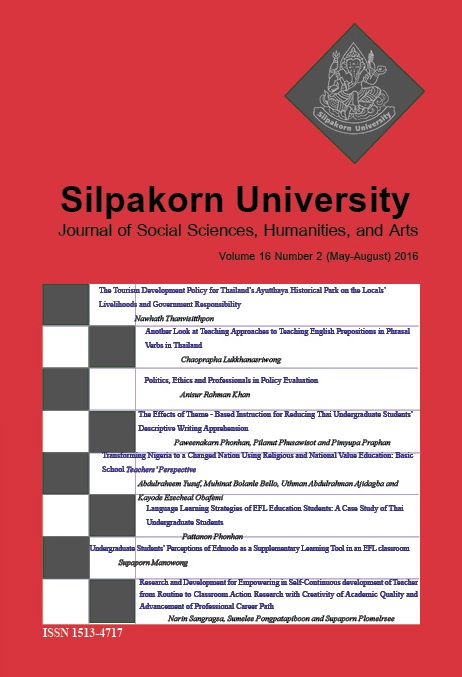The Tourism Development Policy for Thailand’s Ayutthaya Historical Park on the Locals’ Livelihoods and Government Responsibility
Main Article Content
Abstract
This research aims to study the social impact assessment (SIA)
aspects from the tourism development policy by connecting the strategic
policy and the development plan at both national and regional levels and
provincial groups in SIA to evaluate people’s living conditions in the city.
The research data were collected by the use of questionnaires approved
by experts. Cronbach’s alpha coefficient was used to ensure content
validity and reliability of the questionnaire (α = 0.725). The questionnaire
consisted of questions concerning economic, social and environmental
issues. It was found that people of different races and religions visited
for business purposes and the port was used as an industrial centre. The
products were improved, and the people could access local culture easily.
Local people gained more income and activities. The overall examination
and evaluation of tourism-promoting policies should be done. The locals
can participate in tourism development policy presentations. Not only
would investors realise the advantages, but the community would also
be strengthened and unity and utility would directly be created between
province and the community.
Downloads
Article Details
All rights reserved. Apart from citations for the purposes of research, private study, or criticism and review,no part of this publication may be reproduced, stored or transmitted in any other form without prior written permission by the publisher.
References
Jordan, J., Vogt, C. and DeShon, R. (2015) A stress and coping framework for understanding resident responses to tourism development. Tourism Management 48: 500–512.
Joseph, M., Cheer Keir, J., Jennifer, R., Laing, H. (2015) Tourism and Traditional Culture: Land Diving In Vanuatu. Annals of Tourism Research 43: 435–455.
Kim, K., Muzaffer, U. and Sirgy, M. J. (2013) How does tourism in a community impact the quality of life of community residents? Tourism Management 36: 527–540.
Kirkpatrick, C. and Lee, N. (Editors). (1997) Sustainable development in a developing world: Integrating socioeconomic appraisal and environmental assessment. Cheltenham: Edward Elgar.
Kline, C. S., Cardenas, D., Viren, P. P. and Swanson, J. R. (2015) Using a Community Tourism Development Model to Explore Equestrian Trail Tourism Potential in Virginia. Destination Marketing & Management In Press 4(2): 79–87.
Langston, C. and Ding G. K. C. (Editors). (2001) Sustainable Practices in the Built Environment, 2nd ed., Oxford: Butterworth-Heinemann.
Mbaiwa, J. (2011) Changes on traditional livelihood activities and lifestyles caused by tourism development in the Okavango Delta, Botswana.Tourism Management 32(5): 1050–1060.
Seidl, A. (2014) Cultural Ecosystem Services and Economic Develop-ment: World Heritage and Early Efforts at Tourism in Albania. Ecosystem Services 10: 164–171.
Sinclair-Maragh, G., Gursoy, D., Vieregge, M. (2015) Residents perceptions toward tourism development: A factor-cluster approach. Destination Marketing & Management 4(1): 36–45.
Sutawa, G. (2012) Issues on Bali Tourism Development and Community Empowerment to Support Sustainable Tourism Development. Procedia Economics and Finance 4: 413–422.
Thanvisitthpon, N. (2015) A social impact assessment of the tourism development policy on a heritage city, Ayutthaya Historical Park, Thailand. Asian Tourism Management 6(2): 103–144.
Unalan, D. (2013) Integrating cumulative impacts into strategic environmental decision-making: Tourism development in Belek Turkey Land. Use Policy 34: 243–249.
World Tourism Organization. (1985) The States’ Role in Protecting and Promoting Culture as a Factor of Tourism Development and the Proper Use and Exploitation of the National Cultural Heritage of Sites and Monuments for Tourists. Madrid, Spain: World Tourism Organization.
Yankholmes, A. K. B. (2013) Residents Stated Preference for Scale of Tourism Development in Danish-Osu, Ghana. Cities 31: 267–275.


